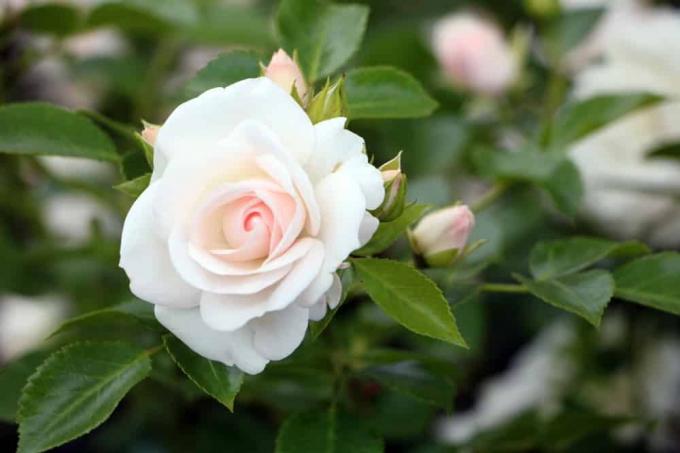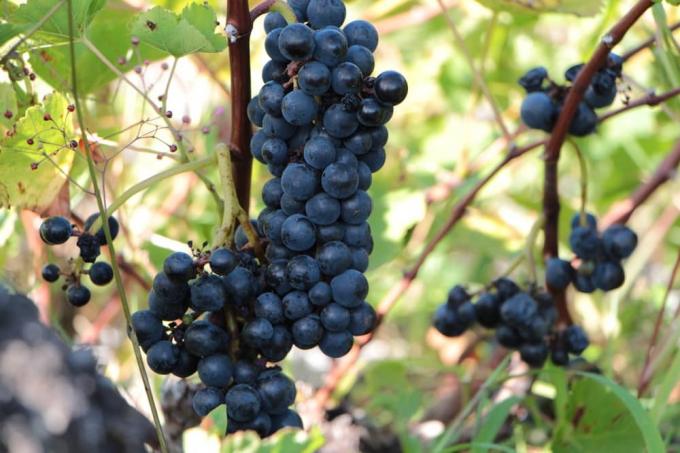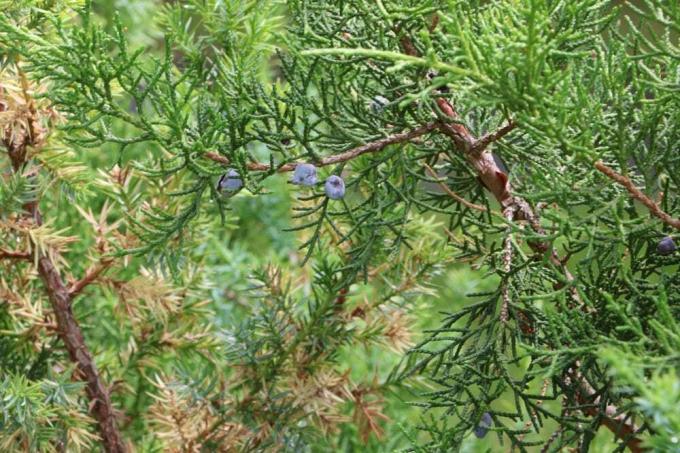

Table of contents
- What are wild shoots?
- What are the characteristics of wild shoots on roses?
- Typical features of wild shoots at a glance
- Wild shoots always grow below the grafting point
- Can't wild shoots also grow above the grafting site?
- Why is it important to remove wild shoots?
- How and when do you remove wild rose shoots?
- Can the wild budding be prevented in advance?
Hybrid tea roses with their tall growth and beautiful flowers are an enchanting eye-catcher in the garden. However, after some time - sometimes even after many years - they develop strange-looking shoots with buds that look very different from the original strain. These are wild shoots that must be removed - otherwise they will soon displace the noble variety. How to correctly identify and remove wild shoots.
What are wild shoots?
Hybrid teas are basically two plants, as these varieties were created from a wild rootstock (known as the "wildling") and the grafted hybrid tea. To do this, the breeders cut off the crown and – if it is not a standard rose – also the woody parts of the wildling above ground, so that only the rootstock remains. The scion is then refined, which finally sprout after successful growth and develops leaves and flowers. In many cases - sometimes even years later - wild shoots appear that grow directly from the rootstock. This behavior is completely natural, after all, the rootstock is also a plant that wants to develop and grow.
What are the characteristics of wild shoots on roses?
An old gardener's wisdom says that rose shoots with five leaves are left standing, while branches with six or even seven leaves must be removed. Basically, this rule is only a guide, because not all hybrid tea roses only have five leaves - some have significantly more, six, seven or even nine leaves. Also, a wild shoot does not always have to look significantly different than the scion, because of the shape and color of the leaves are also dependent on the varieties used - just like the shape of the spines or the hardness of the shoots.
Typical features of wild shoots at a glance
Since seedlings of the dog rose (Rosa canina) and the multiflora rose (Rosa multiflora) are often used for hybrid tea roses, you can pay attention to the following characteristics:
- Foliage is often lighter than the noble variety
- Shoots, leaves and spines grow in a different direction
- Shoots grow noticeably faster than noble shoots
- Branches can (slightly) overhang
- white-pink or pink, single flowers appear between June and July
Wild shoots always grow below the grafting point

However, the most important distinguishing feature is this: Wild shoots always grow well below the grafting point. If you are unsure whether it is a wild instinct or not, check where it originated. The grafting point is quite easy to recognize: it is located in most hybrid tea rose varieties 'just above the rootstock and appears as more or less pronounced Thickening. Since the grafting point should always be buried in roses, place to check the shoot origin free the root neck: if the shoot comes from a place below the thickening, it is a wild drive. On the other hand, if it grows above, it is a scion.
Tip:
In the case of tree roses, the wild shoots can also sprout directly on the trunk and well above the ground. Here, the grafting point is often only at the end of the trunk, since only the crown of the noble variety was grafted onto the root system and the trunk of the wildling.
Can't wild shoots also grow above the grafting site?
With old roses in particular, it sometimes seems as if the wild shoots were also growing above the grafting point. From a botanical point of view, this is not possible, but it is easy to explain: If the rose has been in its place for a long time, the grafting point can be exposed over time - for example, because rainwater washes away the soil or the gardener unintentionally removes the soil himself by working it with a hoe or other garden tool has. If it seems to you that the wild shoots are sprouting from the wrong part of the plant, take a look to see whether the grafting point has been uncovered. In this case, remove the wild shoots and pile up the rose so that the thickening is at least five centimeters below the surface.
Why is it important to remove wild shoots?
Remove wild shoots as soon as possible, as they
- grow stronger and faster than the noble variety
- rob the noble variety of nutrients, water and light
- gradually displace the noble variety
In some cases it can happen that the grafted part of the plant is literally rejected by the strong growth of the wildling. In most cases, however, the scion only dies off gradually, the more the wild substrate pushes through. Many an inexperienced gardener enjoys a supposedly two-colored rose for a few years - until one part of the plant has completely displaced the other. Remember that noble varieties are always weaker and more vulnerable than wild roses. After all, this is also the reason why they are grafted onto a wild rootstock - this is how the gardener combines beauty with robustness.
How and when do you remove wild rose shoots?
Always remove wild rose shoots as soon as you spot them. In this case, you do not need to stick to specific, ideal times for a pruning, but can take action at any time. First, make sure that it is actually a wild shoot and then proceed as follows:
- Expose the origin of the wild shoot, this is often at the root neck, i. H. down in the soil.
- Press the shoot down lightly with your thumb and, if necessary, cut it slightly and tear it off with a strong jerk.
- This will also remove what is known as the astringe, which is a ring-shaped lump.
- If this is not removed, the underlay will sprout again at this point.
- If there is a threat of larger bark injuries, you can also cut.
- However, this is suboptimal, since the rootstock is stimulated to sprout again.
Can the wild budding be prevented in advance?

In principle, wild shoots cannot be completely avoided, as they are completely natural plant behavior. However, you can curb the wild growth with a few tricks:
- Always bury the grafting site if possible
- If possible, do not cut wild shoots, but tear them
- Always remove wild shoots directly at their source
- also remove the tissue capable of dividing (the "astring")
- Never cut wild shoots just above the ground
- then they will only sprout even stronger
Tip:
Since the grafting point is also buried in roses, the hybrid tea can take root after a while and thus become independent of its rootstock. So keep looking to see where the supposedly wild shoots actually come from – shoots growing out of the ground can also belong to the noble variety.
 garden editorial
garden editorial I write about everything that interests me in my garden.
Learn more about W for juniper

Wollziest, Stachys byzantina: Dog-ear care instructions
The Wollziest is a robust and easy-care plant that presents itself with soft, hairy, silver-grey leaves. If the conditions in terms of care, location and substrate are right, the perennial will thrive. The plant can be cultivated both in the garden and in the bucket.

Grapevine, Vitis: care from A-Z | 21 tips for your own grapes
Grapes from your own garden are not just a fresh snack for in between. There are numerous grape varieties around the world. Table vines or table grapes, which were specially bred for fresh consumption, are particularly suitable for cultivation in the home garden.

47 forest plants from A-Z | What plants grow in the forest?
Everyone knows the forest, but what grows there is mostly unknown. Coniferous, mixed and deciduous forests are home to a large number of different plants. Getting to know them is not only a little adventure but an enrichment - also for the menu.

Rocket juniper, Juniperus scopulorum: care tips
The rocket juniper (Juniperus scopulorum) is also known as columnar juniper and can reach impressive heights. Here we show how it can be cultivated successfully. There are also some care tips that can strengthen growth and the plant.

Keep conifers in the bucket - thuja, cypress and rocket juniper
Evergreen trees and shrubs are an attractive sight all year round because they do not shed their leaves in autumn. Thuja, cypress, and rocket juniper all thrive in pots, provided their needs are considered and they are given the right care.

Cut juniper - as a hedge, bonsai and solitary plant
As a key element in creative garden design, juniper enjoys worldwide popularity. Its frugal cut tolerance contributes significantly to this. This applies to cultivation as an elegant hedge, artistic bonsai and eye-catching specimen. Here you can find out how to professionally trim a juniper so that it retains its individual silhouette for many years.



